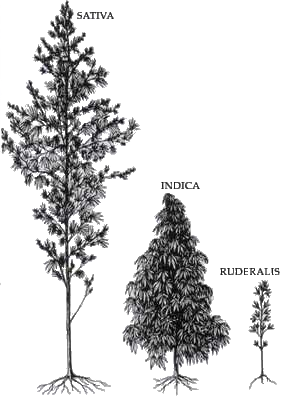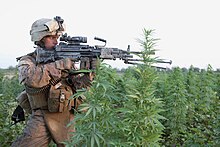
Cannabis is a genus of flowering plants in the family Cannabaceae. The number of species within the genus is disputed. Three species may be recognized: Cannabis sativa, C. indica, and C. ruderalis. Alternatively, C. ruderalis may be included within C. sativa, all three may be treated as subspecies of C. sativa, or C. sativa may be accepted as a single undivided species. The genus is widely accepted as being indigenous to and originating from Asia.

The Marihuana Tax Act of 1937, Pub. L.Tooltip Public Law 75–238, 50 Stat. 551, enacted August 2, 1937, was a United States Act that placed a tax on the sale of cannabis. The H.R. 6385 act was drafted by Harry Anslinger and introduced by Rep. Robert L. Doughton of North Carolina, on April 14, 1937. The Seventy-fifth United States Congress held hearings on April 27, 28, 29th, 30th, and May 4, 1937. Upon the congressional hearings confirmation, the H.R. 6385 act was redrafted as H.R. 6906 and introduced with House Report 792. The Act is referred to, using the modern spelling, as the 1937 Marijuana Tax Act. It was overturned in 1969 in Leary v. United States, and was repealed by Congress the next year.

The LaGuardia Committee report was an official scientific report published in 1944 that questioned the prohibition of cannabis in the United States. The report contradicted claims by the U.S. Treasury Department that smoking marijuana deteriorates physical and mental health, assists in criminal behavior and juvenile delinquency, is physically addictive, and is a "gateway" drug to more dangerous drugs.

In the United States, increased restrictions and labeling of cannabis as a poison began in many states from 1906 onward, and outright prohibitions began in the 1920s. By the mid-1930s cannabis was regulated as a drug in every state, including 35 states that adopted the Uniform State Narcotic Drug Act. The first national regulation was the Marihuana Tax Act of 1937.
The history of medicinal cannabis goes back to the ancient times. Ancient physicians in many parts of the world mixed cannabis into medicines to treat pain and other ailments. In the 19th century, cannabis was introduced for therapeutic use in Western Medicine. Since then, there have been several advancements in how the drug is administered. Initially, cannabis was reduced to a powder and mixed with wine for administration. In the 1970s, synthetic THC was created to be administered as the drug Marinol in a capsule. However, the main mode of administration for cannabis is smoking because its effects are almost immediate when the smoke is inhaled. Between 1996 and 1999, eight U.S. states supported cannabis prescriptions opposing policies of the federal government. Most people who are prescribed marijuana for medical purposes use it to alleviate severe pain.

Cannabis in India has been known to be used at least as early as 2000 BCE. In Indian society, common terms for cannabis preparations include charas (resin), ganja (flower), and bhang, with Indian drinks such as bhang lassi and bhang thandai made from bhang being one of the most common legal uses.

Cannabis is illegal in Nigeria, yet the country is a major source of West African-grown cannabis, and ranked the world's third highest consumer of cannabis.
Cannabis in Greece is illegal for recreational purposes. In 2017, the Greek government legalized the use of cannabis for medical purposes, and a year later, they lifted the ban on growing or producing it. This enables pharmaceutical companies to grow cannabis legally, and industrial hemp suppliers too.

Cannabis has been cultivated in Japan since the Jōmon period of Japanese prehistory approximately six to ten thousand years ago. As one of the earliest cultivated plants in Japan, cannabis hemp was an important source of plant fiber used to produce clothing, cordage, and items for Shinto rituals, among numerous other uses. Hemp remained ubiquitous for its fabric and as a foodstuff for much of Japanese history, before cotton emerged as the country's primary fiber crop amid industrialization during the Meiji period. Following the conclusion of the Second World War and subsequent occupation of Japan, a prohibition on cannabis possession and production was enacted with the passing of the Cannabis Control Law.

Cannabis in Mexico is legal for both recreational and medicinal purposes. It became legal for recreational purposes in June 2021, upon application and issuance of a permit from the health secretariat, COFEPRIS. On 29 June 2021, the Supreme Court of Mexico decriminalized the recreational use of cannabis. President Andrés Manuel López Obrador signed a bill that allows adults 18 and over to possess up to 28 grams of cannabis and grow up to six marijuana plants on their property.
The list includes and details significant events that occurred in the global history of national-level implementations of, or changes made to, laws surrounding the use, sale, or production of the psychoactive drug cannabis.

Terms related to cannabis include:
Cannabis is illegal in Vietnam, but is cultivated within the country and is known as cần sa.

The history of cannabis and its usage by humans dates back to at least the third millennium BC in written history, and possibly as far back as the Pre-Pottery Neolithic B based on archaeological evidence. For millennia, the plant has been valued for its use for fiber and rope, as food and medicine, and for its psychoactive properties for religious and recreational use.
Mariajuana Smoking in Panama is the title of a 1933 report created by United States Army Medical Corps Colonel Joseph Franklin Siler for the Commanding General of the Army's Panama Canal Department concerning cannabis (marijuana) use by U.S. military members. Use at that time in the Panama Canal Zone, then a U.S. territory, was a concern for military discipline and health.
During the administration of American President Lyndon B. Johnson (1963–1969), the government made moves to reconsider cannabis law enforcement in the nation, including a more treatment-based approach to drug use. However, Johnson was saddled with controversies regarding the Vietnam War and internal national tensions, and was not able to make major changes to cannabis policy before declining to run for a second term in 1968. During the Johnson administration, cannabis usage was an issue of concern both in the youth counterculture as well as among American troops serving in the Vietnam War.

The following outline is provided as an overview of and topical guide to the plant Cannabis sativa and its relatives Cannabis indica and Cannabis ruderalis, the drug cannabis (drug) and the industrial product hemp.
Use of mind-altering substances in warfare has included drugs used for both relaxation and stimulation. Historically, drug use was often sanctioned and encouraged by militaries through including alcohol and tobacco in troop rations. Stimulants like cocaine and amphetamines were widely used in both World Wars to increase alertness and suppress appetite. Drug use can negatively affect combat readiness and reduce the performance of troops. Drug use also poses additional expenses to the health care systems of militaries.

Cannabis use during the Vietnam War became prevalent during the late 1960s and 1970s. This is primarily due to the usage of marijuana in the United States increasing along with soldiers using it as an escape from the conflicts around them. The United States Government implemented policies and rules to stop the growing usage of marijuana and other substances, such as heroin. When the media in the United States learned about the usage of marijuana and heroin, they decided to write sensational news articles which often exaggerated the use of the substances.










